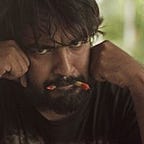Punalur Rajan: Lens that chronicled Kerala’s political-literary history
“Anargha Nimishangal” (Invaluable moments). That’s what Punalur Rajan called the ongoing series of his photographs in the Mathrubhumi weekly. The photographs, fished out from his mammoth archives each week, had lived up to the column’s name, which also happens to be a tribute to his favourite writer Vaikom Muhammad Basheer who has written a story by that name.
When I heard about Rajan’s passing away today morning, the first image of his that came to my mind was one of writer S.K.Pottekkatt in a moment of grief, with his head bowed and eyes staring intently at his wife’s body(which is not shown in the image). It is one of those photographs which had the unmistakable Rajan mark.
For the avid readers of Malayalam literature, he is someone who made the faces of their favourite writers familiar to them. These were not images of public appearances, but the kind of images that only a close friend would be able to capture, which he was to many writers, most notably Basheer, whom he tailed relentlessly for three decades, capturing him in his journeys, relaxing by the beach or in a pensive mood at home or sharing a lighter moment with writer M.T.Vasudevan Nair. Basheer’s movements were very cinematic, he has written, and the photographs bear testimony to that.
Through his lens, he wrote the political and cultural history of Kerala, post-60s till the digital camera era, by which time he hung up his boots. If anyone comes close to Basheer in the number of photographs clicked by Rajan, it is Communist leader EMS. In a recent interview, Rajan speaks about his long wait to get a photograph of EMS laughing heartily, which he finally managed during a party event. He has also been a visual chronicler of the left’s cultural interventions, especially the KPAC dramas. This probably prompted the party to send him on a fellowship to Moscow to learn cinematography, though the movie which was planned never happened.
In a column, he had written about his visit to Leo Tolstoy’s home ‘Yasnaya Polyana’, where he wrote all his classics, during his stint in Moscow, and of the images of the two women he clicked from near there. Moscow also happens to be where he shot writer Thakazhi in a suit, in stark contrast to Rajan’s own images of the writer involved in farming activities, an image which is more relatable to his books. Another image from that Moscow stint is of American civil rights activist Angela Davis, being accorded a reception in Moscow after being released from prison. Cosmonaut Valentina Tereshkova too can be seen in one of the photos.
His sense of timing and quest for the unusual image can be seen in a photograph where Indira Gandhi can be seen standing behind a large number of young men sitting on the ground. It was clicked just as Ms.Gandhi was entering the venue of reception for youth delegation before their trip to Berlin. The men, except one or two at the end of the row, are unaware of her arrival, and have hence not stood up in respect. Rajan contrasts this with the famous image of senior Congress leaders standing with their heads bowed before a seated Indira, making clear his keen political sense too.
Despite having a ‘Punalur’ in his name, he had spent a better part of his life in Kozhikode, where he went as a photographer for the Government Medical College in the 1960s. It was the city which brought him and his lens intimately close to many of our greatest writers…and brought us many “anargha nimishangal”.
(Photographs courtesy — Mathrubhumi weekly )
